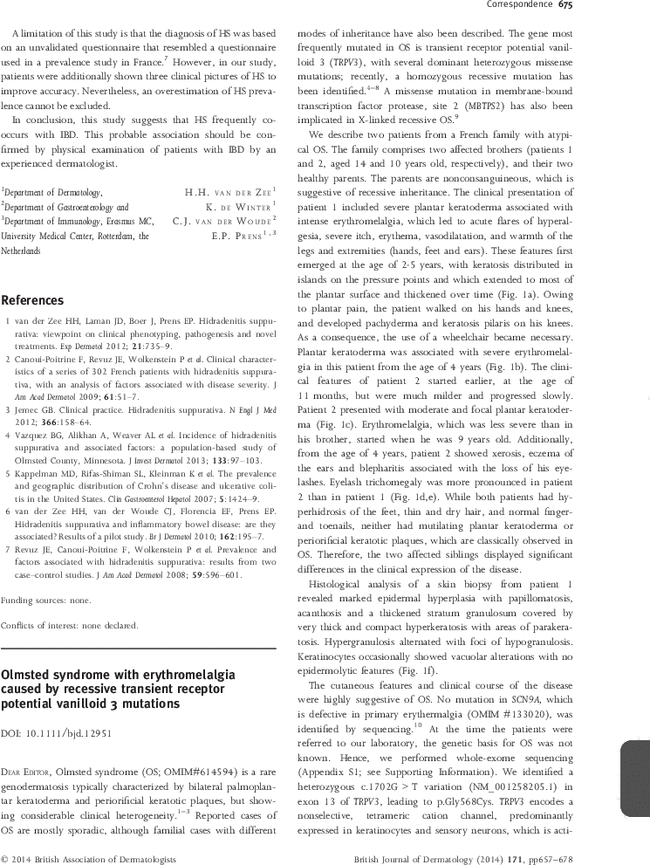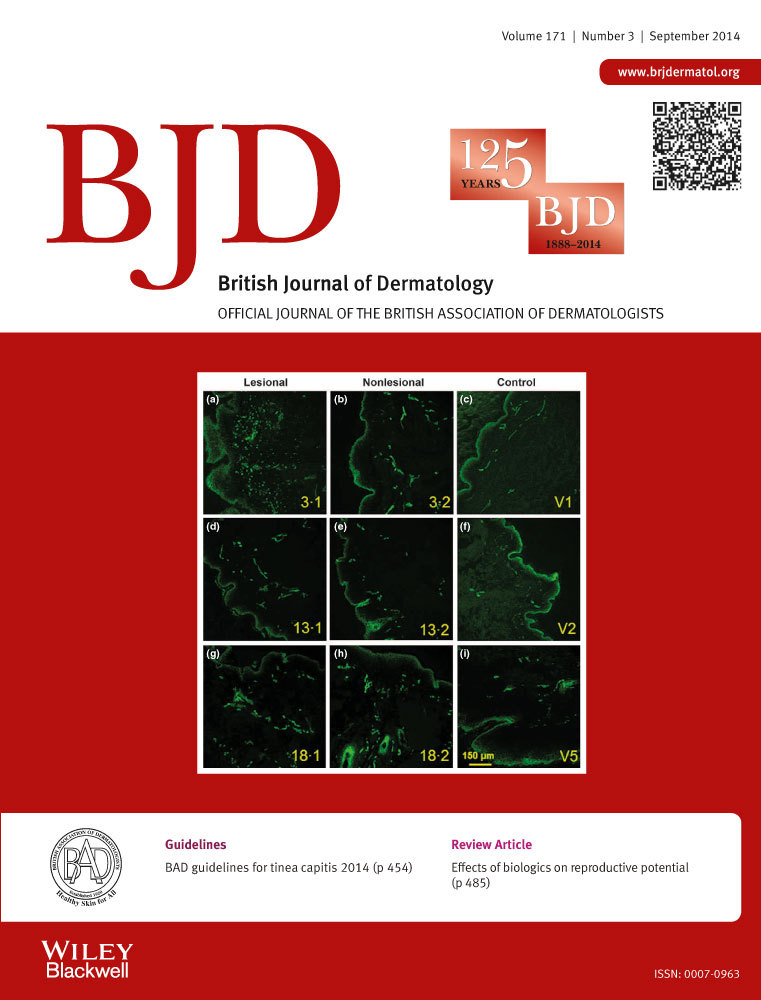Olmsted syndrome with erythromelalgia caused by recessive transient receptor potential vanilloid 3 mutations
S. Duchatelet
INSERM, UMR1163, Institut Imagine, Université Paris Descartes – Sorbonne Paris Cité, Paris, France
Search for more papers by this authorL. Guibbal
INSERM, UMR1163, Institut Imagine, Université Paris Descartes – Sorbonne Paris Cité, Paris, France
Search for more papers by this authorS. de Veer
INSERM, UMR1163, Institut Imagine, Université Paris Descartes – Sorbonne Paris Cité, Paris, France
Search for more papers by this authorS. Fraitag
Department of Pathology, Necker–Enfants Malades Hospital, APHP, Paris, France
Search for more papers by this authorP. Nitschké
Bioinformatics Platform, Institut Imagine, Université Paris Descartes – Sorbonne Paris Cité, Paris, France
Search for more papers by this authorM. Zarhrate
Genomics Platform, Institut Imagine, Necker–Enfants Malades Hospital, Paris, France
Search for more papers by this authorCorresponding Author
C. Bodemer
Department of Dermatology, Institut Imagine, Necker–Enfants Malades Hospital, National Reference Centre for Genodermatoses (MAGEC), Université Paris Descartes – Sorbonne Paris Cité, Paris, France
Correspondence: Christine Bodemer and Alain Hovnanian
E-mails: [email protected] and [email protected]
Search for more papers by this authorCorresponding Author
A. Hovnanian
Department of Genetics, INSERM, UMR1163, Institut Imagine, Necker–Enfants Malades Hospital, Université Paris Descartes – Sorbonne Paris Cité, Paris, France
Correspondence: Christine Bodemer and Alain Hovnanian
E-mails: [email protected] and [email protected]
Search for more papers by this authorS. Duchatelet
INSERM, UMR1163, Institut Imagine, Université Paris Descartes – Sorbonne Paris Cité, Paris, France
Search for more papers by this authorL. Guibbal
INSERM, UMR1163, Institut Imagine, Université Paris Descartes – Sorbonne Paris Cité, Paris, France
Search for more papers by this authorS. de Veer
INSERM, UMR1163, Institut Imagine, Université Paris Descartes – Sorbonne Paris Cité, Paris, France
Search for more papers by this authorS. Fraitag
Department of Pathology, Necker–Enfants Malades Hospital, APHP, Paris, France
Search for more papers by this authorP. Nitschké
Bioinformatics Platform, Institut Imagine, Université Paris Descartes – Sorbonne Paris Cité, Paris, France
Search for more papers by this authorM. Zarhrate
Genomics Platform, Institut Imagine, Necker–Enfants Malades Hospital, Paris, France
Search for more papers by this authorCorresponding Author
C. Bodemer
Department of Dermatology, Institut Imagine, Necker–Enfants Malades Hospital, National Reference Centre for Genodermatoses (MAGEC), Université Paris Descartes – Sorbonne Paris Cité, Paris, France
Correspondence: Christine Bodemer and Alain Hovnanian
E-mails: [email protected] and [email protected]
Search for more papers by this authorCorresponding Author
A. Hovnanian
Department of Genetics, INSERM, UMR1163, Institut Imagine, Necker–Enfants Malades Hospital, Université Paris Descartes – Sorbonne Paris Cité, Paris, France
Correspondence: Christine Bodemer and Alain Hovnanian
E-mails: [email protected] and [email protected]
Search for more papers by this author
Supporting Information
| Filename | Description |
|---|---|
| bjd12951-sup-0001-FigS1-S2-AppendixS1.docWord document, 2.7 MB | Fig. S1. Localization and modelling of the p.Gly568Cys transient receptor potential vanilloid 3 (TRPV3) mutation. (a) TRPV3 ortholog alignment of transmembrane domain S4, linker region and S5. Gly568 (indicated in blue) is a highly conserved residue. The mutated residue (Gly573) previously identified in Olmsted syndrome (OS), as well as in spontaneous mutant rodents, is indicated in green. (b–d) Location of Gly568 and Gly573 in the structure of TRPV1 and the effects of mutations. (b) Structural overview of a TRPV1 subunit (PDB ID 3J5P). Elements that comprise the channel-forming unit are colour-coded as indicated in the key (right of the panel). Gly568 and Gly573 (TRPV3 numbering) are located within the black rectangle. (c) Magnified image of the position of Gly568, Gly573 and Trp692. Amino acid side chains are shown in stick representation (note that, essentially, Gly has no side). Helices are coloured as in (b). (d) Structural consequences of p.Gly568Cys (recessive), p.Gly573Ala (dominant), p.Gly573Ser (dominant) and p.Gly573Cys (dominant) mutations. Note that all Gly573 substitutions extend into the area occupied by Trp692 (grey shading), leading to rearrangement in the S4–5 linker and/or transient receptor potential (TRP) domain. Fig. S2. Characterization of the splice site mutation, localization and modelling of the resulting p.Gln216_Gly262del mutation. (a) Reverse transcription polymerase chain reaction from exon 6 to exon 11 showed a band corresponding to normal splicing of exon 6–11 [911 base pairs (bp)], and a smaller band resulting from exon 7 skipping (770 bp). (b) Transient receptor potential vanilloid 3 (TRPV3) ortholog alignment of part of the ankyrin repeat domain (ARD). Ankyrin repeat AR3 and its secondary structure elements (inner and outer helices) are indicated. The p.Gln216_Gly262del deletion, resulting from in-frame exon 7 skipping is indicated in blue. (c) Structure of the TRPV3 ARD (PDB ID 4N5Q) with the inner helix (upper) and outer helix (lower) of each AR shown in a separate colour. Finger 3 is highlighted in magenta. (d) Model of the mutant TRPV3 ARD resulting from p.Gln216_Gly262del. Finger 3* (finger 2 in wild-type TRPV3) is different in sequence and length to finger 3 in wild-type TRPV3 and will likely adopt a different conformation. Appendix S1. Methods. |
Please note: The publisher is not responsible for the content or functionality of any supporting information supplied by the authors. Any queries (other than missing content) should be directed to the corresponding author for the article.
References
- 1Olmsted HC. Keratodermia palmaris et plantaris congenitalis: report of a case showing associated lesions of unusual location. Am J Dis Child 1927; 33: 757–64.
- 2Mevorah B, Goldberg I, Sprecher E et al. Olmsted syndrome: mutilating palmoplantar keratoderma with periorificial keratotic plaques. J Am Acad Dermatol 2005; 53: S266–72.
- 3Tao J, Huang CZ, Yu NW et al. Olmsted syndrome: a case report and review of literature. Int J Dermatol 2008; 47: 432–7.
- 4Lin Z, Chen Q, Lee M et al. Exome sequencing reveals mutations in TRPV3 as a cause of Olmsted syndrome. Am J Hum Genet 2012; 90: 558–64.
- 5Danso-Abeam D, Zhang J, Dooley J et al. Olmsted syndrome: exploration of the immunological phenotype. Orphanet J Rare Dis 2013; 8: 79.
- 6Lai-Cheong JE, Sethuraman G, Ramam M et al. Recurrent heterozygous missense mutation, p.Gly573Ser, in the TRPV3 gene in an Indian boy with sporadic Olmsted syndrome. Br J Dermatol 2012; 167: 440–2.
- 7Duchatelet S, Pruvost S, de Veer S et al. A new TRPV3 missense mutation in a patient with Olmsted syndrome and erythromelalgia. JAMA Dermatol 2014; 150: 303–6.
- 8Eytan O, Fuchs-Telem D, Mevorach B et al. Olmsted syndrome caused by a homozygous recessive mutation in TRPV3. J Invest Dermatol 2014; 134: 1752–4.
- 9Haghighi A, Scott CA, Poon DS et al. A missense mutation in the MBTPS2 gene underlies the X-linked form of Olmsted syndrome. J Invest Dermatol 2012; 133: 571–3.
- 10Yang Y, Wang Y, Li S et al. Mutations in SCN9A, encoding a sodium channel alpha subunit, in patients with primary erythermalgia. J Med Genet 2004; 41: 171–4.
- 11Cao E, Liao M, Cheng Y et al. TRPV1 structures in distinct conformations reveal activation mechanisms. Nature 2013; 504: 113–18.
- 12Phelps CB, Wang RR, Choo SS et al. Differential regulation of TRPV1, TRPV3, and TRPV4 sensitivity through a conserved binding site on the ankyrin repeat domain. J Biol Chem 2009; 285: 731–40.
- 13Shi DJ, Ye S, Cao X et al. Crystal structure of the N-terminal ankyrin repeat domain of TRPV3 reveals unique conformation of finger 3 loop critical for channel function. Protein Cell 2013; 4: 942–50.
- 14Inada H, Procko E, Sotomayor M et al. Structural and biochemical consequences of disease-causing mutations in the ankyrin repeat domain of the human TRPV4 channel. Biochemistry 2012; 51: 6195–206.
- 15Nilius B, Biro T. TRPV3: a ‘more than skinny’ channel. Exp Dermatol 2013; 22: 447–52.




